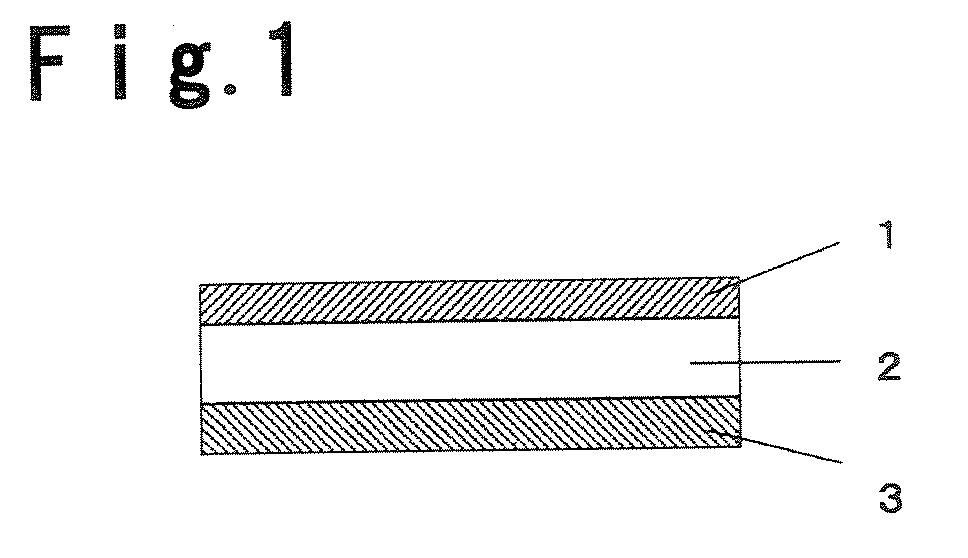Laminate for flexible printed wiring board
a technology of flexible printing and laminate, which is applied in the direction of synthetic resin layered products, instruments, transportation and packaging, etc., can solve the problems of circuit operation failure and insufficient utilization of low dielectric properties of fluororesin, and achieve excellent adhesion, excellent flexing resistance, and excellent adhesion
- Summary
- Abstract
- Description
- Claims
- Application Information
AI Technical Summary
Benefits of technology
Problems solved by technology
Method used
Image
Examples
example 1
[0054]A polymerization tank having an internal capacity of 94 L and equipped with a stirrer, was deaerated, and 71.3 kg of 1-hydrotridecafluorohexane (hereinafter referred to as HTH), 20.4 kg of 1,3-dichloro-1,1,2,2,3-pentafluoropropane (AK225cb manufactured by Asahi Glass Company, Limited, hereinafter referred to as AK225cb), 562 g of CH2═CH(CF2)2F and 4.45 g of IAH were charged. The interior of the polymerization tank was heated to 66° C., and an initial monomer mixed gas of TFE / E in a molar ratio of 89 / 11 was introduced to raise the pressure to 1.5 MPa / G. As a polymerization initiator, 1 L of a 0.7% HTH solution of tert-butyl peroxypivalate was charged to initiate the polymerization. In order to maintain the pressure to be constant during the polymerization, the monomer mixed gas of TFE / E in a molar ratio of 59.5 / 40.5 was continuously charged. Further, CH2═CH(CF2)2F in an amount corresponding to 3.3 mol % and IAH in an amount corresponding to 0.8 mol %, based on the total molar a...
example 2
[0059]The polymerization tank used in Example 1 was deaerated, and 902 kg of AK225cb, 0.216 kg of methanol, 31.6 kg of CF2═CFOCF2CF2CF3 and 0.43 kg of IAH were charged. The interior of the polymerization tank was raised to 50° C., and TFE was charged until the pressure became 0.38 MPa. As a polymerization initiator solution, 50 mL of 0.25% AK225cb solution of di(perfluorobutyryl) peroxide was charged to initiate the polymerization. In order to maintain the pressure to be constant during the polymerization, TFE was continuously charged. The above polymerization initiator solution was additionally added as the case requires, and the charging rate of TFE was maintained to be substantially constant. The polymerization initiator solution was charged in a total amount of 120 mL. Further, IAH in an amount corresponding to 1 mol % of TFE continuously charged, was charged. After 6 hours from the initiation of the polymerization and when 7.0 kg of TFE was charged, the interior of the polymeri...
example 3
[0064]In the same manner as in Example 1 except that a polyether ether ketone (PEEK381G, manufactured by VICTREX) having a thickness of 18 μm and a width of 380 mm was used instead of the polyimide resin as the reinforcing layer (A), a three layer laminated film 3 composed of layer of polyether ether ketone / layer of fluorocopolymer 1 / layer of rolled copper foil and having a thickness of 68 μm, was obtained. In the laminated film 3, the peel strength between the layer of the fluorocopolymer 1 and the layer of the rolled copper foil was 28 N / 10 mm, and the peel strength between the layer of the polyether ether ketone and the layer of the fluorocopolymer 1 was 21 N / 10 mm, thus showing an adequate adhesive force. The number of MIT bending times of the laminated film 3 was 3,300 times.
PUM
| Property | Measurement | Unit |
|---|---|---|
| surface roughness | aaaaa | aaaaa |
| thickness | aaaaa | aaaaa |
| thickness | aaaaa | aaaaa |
Abstract
Description
Claims
Application Information
 Login to View More
Login to View More - R&D
- Intellectual Property
- Life Sciences
- Materials
- Tech Scout
- Unparalleled Data Quality
- Higher Quality Content
- 60% Fewer Hallucinations
Browse by: Latest US Patents, China's latest patents, Technical Efficacy Thesaurus, Application Domain, Technology Topic, Popular Technical Reports.
© 2025 PatSnap. All rights reserved.Legal|Privacy policy|Modern Slavery Act Transparency Statement|Sitemap|About US| Contact US: help@patsnap.com


